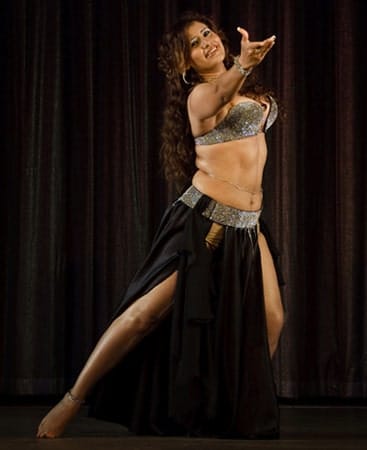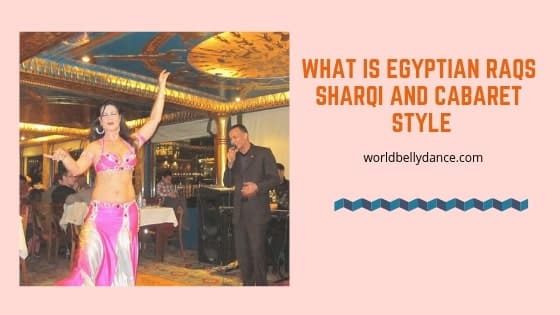Ultimate Updated on January 29, 2024
There are numerous kinds of abdomen dance and on this publish, I will think about Egyptian Raqs Sharqi and cabaret-style. This mannequin is type of completely totally different from abdomen dance abdomen from areas paying homage to Turkey and Morocco and has its private historic previous!
Egyptian Raqs Sharqi (or Raks Sharki), moreover generally known as Egyptian cabaret, is a type of dance that has its roots in Egyptian social and folkloric dances nonetheless has been influenced by western dance genres.
Notably, from the beginning, it was influenced by vaudeville elements as one of many essential influential figures throughout the historic previous of Egyptian Raqs sharqi, Badia Masabni, started her occupation in vaudeville theatres.
From its origins to our days, Egyptian Raqs sharqi has modified and it has unfold all around the world. Nonetheless, it maintains positive elements that distinguish it from totally different genres.
Origins and Developments
Egyptian mannequin Raqs Sharqi as everyone knows it as we converse originates from the early twentieth century in Egypt.
It developed in Cairo throughout the Nineteen Twenties in nightclubs paying homage to Badiaa Masabni’s ‘Opera On line on line casino’. Badia Masabni’s establishment was not the one one on the time, however it absolutely was most likely essentially the most influential throughout the progress of this dance kind.
Badiaa Masabni wished to enchantment to a world and upper-class viewers, so her choreographies started incorporating a much bigger use of the stage, loads of footwork and influences from western dances paying homage to ballet and ballroom dances.
Badia herself had travelled masses, having lived for some time in Argentina and having carried out internationally (she was an accomplished actress, singer and dancer).
From the beginning, Raqs Sharqi included Baladi and folkloric actions, along with western influences which can be seen in utilizing turns, touring steps, and a additional lifted feeling than the conventional native dances.
Moreover, the dance started being choreographed for group dances and carried out on a stage. Lately, we’re capable of uncover examples of Raqs sharqi being carried out all around the globe.
In Egypt, they dance it in boats on the Nile, in resorts, and at expensive weddings.


Outside of Egypt, it tends to be carried out on stage at festivals and haflas.
From the Thirties until the Nineteen Eighties there have been loads of Raqs Sharqi dance scenes in Egyptian movies, nonetheless, on the time of writing, oriental dance seems to have disappeared from Egyptian cinema.
Raqs Sharqi and Cabaret Music
Egyptian mannequin music incorporates orchestras with many gadgets.
They embrace typical Middle Jap gadgets paying homage to tabla (this is not to be confused with the Indian tabla, as tabla may be the phrase that Egyptians used to seek the advice of with the goblet drum, which in numerous Middle Jap worldwide areas is named doumbek or darbuka), nay, kanoun and often western ones, paying homage to violin, trumpet accordion.
The latter was launched to Egyptian music concurrently the introduction of Western influences throughout the dance, throughout the Nineteen Twenties golf tools in Cairo.
Lately every typical acoustic gadgets and classy and electrical ones, paying homage to keyboards, are used.
Examples of Egyptian Raqs Sharqi music are Hossam Ramzy’s or Hassan Abou El Seoud’s music.
Moreover, given that Nineteen Seventies, dancers started to hold out to songs that weren’t initially written for dancing, nonetheless which later had been used for this operate, paying homage to songs written for Oum Koultoum.
Soheir Zaki, throughout the Nineteen Seventies, is alleged to have been the first dancer to hold out to Oum Koultoum’s songs. Since then, fairly a number of variations of these songs have been tailor-made for dancing to.
Properly-known Dancers
Properly-known Egyptian Raqs dancers embrace the dancers/ choreographers Raqia Hassan and Ibrahim Akef, dancers Nagwa Fouad and Soher Zaki throughout the Nineteen Seventies/80s, and, among the many many updated abdomen dance legends, Dina, Randa Kamel, and Dandesha.
Raqs Sharqi Actions
Inside the Egyptian mannequin, the actions are often additional internalized and small than in several types of abdomen dance, paying homage to Turkish mannequin.
On the an identical time, even the smallest movement in Egyptian Raqs sharqi, if carried out properly, is type of dramatic. Egyptian Raqs embrace some ballet and ballroom dance influences, paying homage to in footwork (as an example utilizing arabesque) and in stance and arm positions, although tailor-made to an oriental mannequin. Floorwork and positive pelvic strikes are banned, as a consequence of Egyptian regulation.
Usually, when dancing with an orchestra, dancers generally tend to maneuver spherical additional and make additional use of the home, whereas if dancing to the sound of 1 or two gadgets (i.e. drums solos) actions are additional restricted to a small area.
Usually Egyptian raqs sharqi dancers make an entrance with a veil, which they discard after regarding the first 30 seconds of dancing.
Inside the outdated events, from the Forties until the Sixties, most dancers used finger cymbals for a number of of their performances, nonetheless as we converse utilizing sagat seems to be very restricted or has almost disappeared from raks sharki performances.
The assaya was utilized in outdated performances, nonetheless initially to not saidi rhythms, which had been launched later throughout the raqs sharqi repertoire (you may uncover this within the occasion you watch dance scenes from outdated Egyptian movies, which you’ll uncover on YouTube and Vimeo).
Usually, evaluating to ghawazee or baladi dance varieties, raqs sharqi is additional lifted (i.e. a lot much less grounded), so dancers stand additional on their tiptoes reasonably than on flat toes. Moreover, the arms switch additional, are additional fluid and are additional lifted.
Often speaking, the mannequin has modified over time, in that the dance throughout the outdated events was additional flowing and delicate, whereas the trendy mannequin tends to be additional energetic, assertive, and dramatic.
Nonetheless, these variations moreover rely largely on each specific individual dancer’s mannequin and character.
Costumes
Often, the Egyptian cabaret costume, generally known as bedlah, is the one which many people as we converse affiliate with raqs sharqi.
That is, the two-piece with bra and hip belt (although today loads of Egyptian cabaret costumes have beads sewed straight onto a good skirt reasonably than a hip belt).
Some costumes are one piece solely, nonetheless all of them are elaborated and with loads of beads.
Egyptian regulation forbids to disclose the stomach, subsequently, even when sporting a two-piece costume set, abdomen dancers in Egypt cowl their torso with a stocking type of material.
Vogue though has modified masses over time and you will uncover it, within the occasion you watch dance scenes from outdated Egyptian movies starting throughout the Thirties down by way of the a very long time and as a lot as films of performances in our events.
Variations typically are refined, nonetheless have dramatic outcomes, paying homage to utilizing wider shoulder straps throughout the Thirties and 40s or alter neck type of bras, to the push up bras that Dina and Randa use as we converse.
Dina was an innovator throughout the Raqs sharqi vogue, as she started using fast skirts and costumes fabricated from lycra, a model new supplies that opened up new potentialities for costume design.
Whereas, before now, skirts had been made primarily of chiffon.
Actually, fashions on a regular basis change and tendencies come once more. So, we’re going to wait to see how vogue will change eventually.
In any case, the major type of the bedlah, with its bra and skirt look has not modified.
Dr Valeria Lo Iacono is a abdomen dancer and a dance researcher with a PhD in dance and heritage. Valeria moreover teaches and performs as a abdomen dance however moreover enjoys learning ballet, jazz dance and totally different dance genres.


